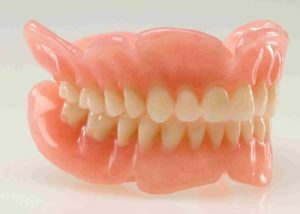 Modern technologies and applied materials expand the therapeutic possibilities of the dental industry, however, it is still impossible to save a tooth.
Modern technologies and applied materials expand the therapeutic possibilities of the dental industry, however, it is still impossible to save a tooth.
In this case, we are talking about prosthetics - the installation of orthopedic structures in the patient's mouth.
Large selection of dentures makes possible the solution of any dental problem. It remains an open question of choosing a particular orthopedic product.
Contents
- Fixed construction
- Partially removable orthopedic structures
- Plate prostheses with complete absence of teeth
- Choosing the orthopedic design
- How to get used to an unusual object in the mouth?
- Care, repair and storage
- From the experience with the use of prostheses
- Price
Fixed construction
Bridging prosthesis is a non-removable design used in the case of minor defects in the dentition( absence of 1-2 teeth in a row).Products are attached to healthy teeth on either side of the existing defect.
The material and method for making the structures determines their appearance:
-
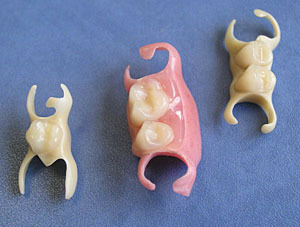
Removable bridgework for one and two teeth
brazed - soldered single crowns, practically not used in modern orthopedics due to poor quality;
- solid - products from cobalt-chromium alloy;
- metal-ceramic - prostheses, equipped with a metal frame covered with ceramic mass, are among the most commonly used and available products;
- ceramic - constructions from zirconium alloy with fusion of porcelain;
- prostheses on ceramic or metal inserts , the installation of which is preceded by the procedure of turning grooves in the supporting teeth to fix the products;
- metal-plastic - temporary construction, installed at the time of the preparation of a permanent bridge;
- adhesive - prostheses made of light-polymer filling material and a strong fiberglass tape playing the role of a beam for artificial teeth.
However, non-removable dentures have a number of significant drawbacks:
- need to grind the supporting teeth;
- a big load on healthy teeth;
- inability to preserve bone tissue.
Partially removable orthopedic structures
Partially removable dental prostheses belong to a variety of devices used in the complete absence of dentition. Prosthesis with partially removable products is carried out if one or more healthy teeth are preserved in the jaw of the patient, i.e., the prosthesis relies not only on the gum but also on the supporting teeth.
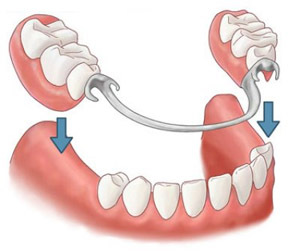 When considering a group of orthopedic products is classified according to the material of manufacture on:
When considering a group of orthopedic products is classified according to the material of manufacture on:
- acrylic ;
- nylon ;
- clasp , representing a metal arc with artificial teeth fixed on it;
- silicone - products made partly of acrylic, nylon, silicone and plastic.
Below in the table the main types of removable dentures are their advantages and disadvantages.
| Type of prosthesis | Pros | Cons |
|---|---|---|
| Acrylic | - reasonable price; - lightness; - a small load on the supporting teeth due to its distribution on the gums; - aesthetic appearance. | - porous structure of the material, which contributes to the accumulation of moisture in the prosthesis and the reproduction of bacteria; - brittleness; - large size; - relatively weak fixation; - violation of diction and perception of tastes. |
| Nylon | - aesthetics; - softness; - hypoallergenicity; - comfort when wearing. | - short service life( 2-3 years); - violation of the fixation of the product due to the gradual precipitation of the material; - lack of uniform distribution of the chewing load. |
| Clasp | - strength; - compact; - a kind of natural jaw; - absence of diction and taste disorders; - not subject to mandatory removal before receiving viscous, sticky food and overnight; - possible application for periodontitis. | - the possibility of rubbing the gums; - a long period of rehabilitation. |
| Silicone | - elasticity; - reliable fixation; - durability; - strength; - hypoallergenicity; - uniform distribution of the chewing load( with incomplete prosthetics); - no need to grind the supporting teeth; - resistance to food colorings; - aesthetics. | - vulnerability to strong chewing load; - propensity to subsidence; - poor polishability; - the need for regular correction; - high cost. |
Plate prostheses in the complete absence of teeth
Plate prostheses are one of the most common designs used to restore the dentition even in case of complete loss of teeth.
Modern products are made of nylon, rubber, acrylic, etc. The base of the prosthesis, which is pink, is made on the basis of an individual cast of the patient's jaw( upper or lower).
It is at the expense of this basis that the remaining parts of the structure( artificial teeth, clas- mers) are joined together, and the chewing load is redistributed to the gums.
A number of advantages of this type of products are:
-
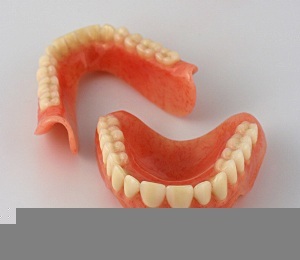
Plate prosthesis for upper and lower jaws
affordable price;
- durability;
- efficiency of manufacturing;
- uniform distribution of the chewing load;
- is easy to clean.
Among the shortcomings of lamellar prostheses:
- discomfort during the period of habituation;
- violation of taste perception;
- need to visit the dentist at least 2 times a year.
Choosing an orthopedic design
On the question of what removable dentures to use is best unequivocal opinion is not. The most popular opinion - removable dentures are designed for people of advanced age. However, in the modern world, among patients of all ages, removable and non-removable products are equally popular.
When making a choice in favor of this or that design, it is necessary to take into account a number of factors:
- Defect size .If there are only a few teeth it is better to give preference to non-removable prosthetics. In the case of a completely toothless jaw, removable dentures are used.
-
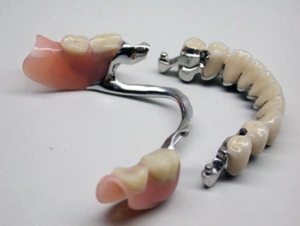
Clasp prosthesis
Psychological attitude .Many do not favor removable orthopedic products, since they believe that they can fall out at the most inopportune moment. Although there are no grounds for concern: provided the quality of the dental procedure is high, the risk of such an incident is minimal.
- Price .Not everyone is able to provide themselves an "unattainable" smile. In such a situation it is necessary to treat the choice of the prosthesis especially carefully, so that the properties and features of the product cover possible shortcomings. Desired result .The patient becomes confronted with a choice: chewing function or creating a magnificent smile. If the priority is first, non-removable designs are better, if the second one is partially removable.
- Comfort .Obviously, the prosthesis should be comfortable to wear.
The most suitable option for holders of toothless jaw will be an acrylic prosthesis. However, in order to improve the fixation of the product, implants can be used, if, of course, the wallet allows.
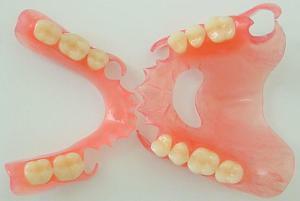
In the photo partially removable laminated nylon prosthesis
Nylon structures are recommended to be used only temporarily. The aesthetics of the products do not overlap the list of "side effects" when worn, and the cost of the structures is quite impressive.
With small defects in the dentition and the absence of the possibility of purchasing non-removable products, the best choice is a clasp prosthesis. It will help not only restore the chewing function, but also strengthen the loosened teeth.
In addition, being in front of the choice, do not forget to take into account contraindications to wearing certain prostheses.
How to get used to an unusual object in your mouth?
To quickly get used to the prosthesis, we recommend that you adhere to the following rules:
- Avoid injuring the inside of the cheeks, tongue and mouth mucous with .For this, chew the food slowly. Give preference to the soft food structure. Temporarily give up nuts, raw vegetables, fruits.
-
 During the period of adaptation to prostheses, difficulties in communication are possible. Try to read aloud, correct your mistakes .
During the period of adaptation to prostheses, difficulties in communication are possible. Try to read aloud, correct your mistakes . - Take the habit of regularly massaging the gums to reduce pain .To do this, put the index finger and thumb on the gums, while the index finger should be on their outer side. Then just massage and rub the painful areas.
- To prevent dry mouth during the first time of wearing dentures, often drink water .
- With excessive salivation of , suck up the lozenges and try to breathe the nose .
Care, repair and storage
The easiest way to clean dentures from food remains is to rinse with water. For this purpose, boiled water is used. In addition, orthopedic structures should be treated with special solutions that are already sold as ready-made form or as a tablet dissolving in water.
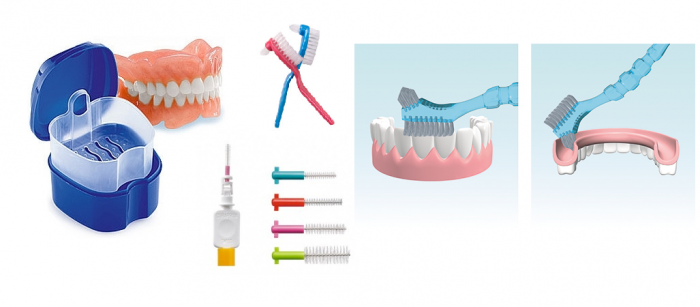
Periodic mechanical cleaning of products using a toothbrush and paste for prostheses is also recommended. All of the above methods are also applicable in the case of partially removable structures, for example, clasp.
Repair of removable dentures takes place only if the artificial teeth have been damaged, in case of a defect in the basis of the design, its complete replacement is required.
What removable dentures exist, how to choose them and how to take care of them will tell the doctor dentist:
From the experience with the use of prostheses
To determine which removable dentures are best and will suit you will help patients' reviews.
To my rather old age I had to remove the molars - I became the owner of a toothless jaw. Given my periodontitis, I opted for clasp removable dentures.
Installation and previous procedures for me were painless, but it was not so easy to adapt: at first I always rubbed my cheeks, gums and tongue, I could not get used to them for a long time, although I did not take pictures for the night.
Pleased with the appearance of products - like real teeth! The design is lightweight, compact. .. In general, I'm happy, for 5 years now prostheses help me out.
Nikita Smirnov, Moscow
With age, prosthetic part of the upper jaw( 2 incisors, 7 on the left, right canine and eight on the right).They put plastic prosthesis, stood for more than 20 years, but eventually sagged.
It was advised to replace it with cermets. Alas, no luck: in 3 years the seven became rotten - the prosthesis should be removed. It's a pity! It is worth something, it's a lot! It would be better if the plastic prosthesis remained. ...
Svetlana Vetrova, Ekaterinburg
My old age mother did not have any teeth at all. .., I decided to tackle this issue: I rummaged a lot of information on the Internet, consulted with specialists. .. As a result, we stopped on an accessible option - plate prostheses.
Made products very quickly. Mom with dentures for six years already. He does not complain, he says it is convenient, although he could not even speak at once. .. True, care is needed, and we try to visit the dentist twice a year.
Ludmila Kudryavtseva, Moscow
Price of the issue
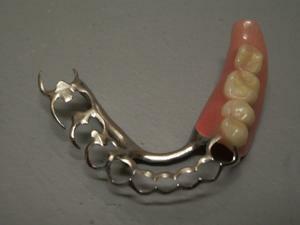
Clasp prosthesis - the most expensive
The cost of dentures depends on the type of product and material of manufacture, sometimes the price of the design is also affected by the price:
- the cost of removable acrylic prostheses per jaw starts from 7000 rubles;
- price for nylon construction is approximately one third higher due to manufacturing of products abroad;
- value for silicone products varies in the range of 30000-35000 rubles;
- the most expensive variant of dental prosthetics - clasp designs, about the sided design on micro-locks will cost in 35000-40000 rubles.
As you can see, the loss of teeth is no longer an irresolvable problem. Modern dental technology is ready to offer the patient a huge selection of prostheses that can easily replace a lost smile.
